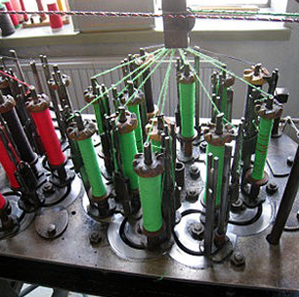
The limitations of the weaving, knitting and stitching processes include poor shear resistance, limited strength in the primary loading direction, and the inability to produce complex shaped parts. These shortcomings, as will be seen, are largely overcome with the adaptation of braiding. Braiding is a simple form of narrow fabric construction. It is done by intertwining of yarns in whatever direction suited the maker’s purpose. This began as a handicraft for the construction of decorative fabrics but the limitations of knitting and weaving made braiding an important method of fabric formation in textile composite manufacturing industry.
Lace making, a domestic art of seventh century, is the beginning of narrow fabric production. Increasing need for tapes in electrical uses, ribbons and laces made this handicraft into a leading industry. The manual efforts were replaced by narrow width looms. There are definite trends towards knitting by the crochet methods in some areas of narrow fabric production. For foundation wear, the trend is towards lighter-weight sheer garments so that the bindings should also be light weight, while, at the same time, fashion trends have dictated that a variety of coloured yarns be incorporated in these bindings. Crochet knitting machines have been found ideal for this purpose and have replaced large numbers of traditional braiding machines.
Types
Braiding can be classified as two and three-dimensional braiding. Two-dimensional braid structure can be circular or flat braid. Three-dimensional braiding is relatively new and was developed mainly for composite structures. Although circular and flat braids have thickness, it is small compared to the other two dimensions; therefore they are considered as two-dimensional.
Two-dimensional braiding
Two-dimensional circular or flat braid is formed by crossing a number of yarns diagonally so that each yarn passes alternately over and under one or more of the others. The most common designs in two-dimensional braids are as follows:
Diamond braids: 1/1 intersection repeat.
Regular braids: 2/2intersection repeat.
Hercules braids: 3/3intersection repeat.
Circular braiding-mechanism
Circular (tubular or round) braids are formed hollow or around a centre core. A circular braiding machine consists of two sets of an even number of spools containing the braiding yarns. One set runs clockwise around the centre of the machine and the other set turn in counterclockwise direction. While revolving in opposite directions, the carriers are diverted to pass alternately inside and outside (under and over) one another. The clockwise and counterclockwise paths cause the two sets of yarns to intersect, thus producing a tubular braid.
The yarns from the yarns are collected above the hub of the circular track in which the bobbins travel. Circular braiders are called as “Maypole Braiders” since their motion is similar to the maypole dance.

